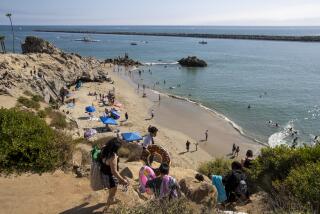Big catches mask dwindling numbers of sea bass
As reliably as masses of sea bass gather off the Southern California coast each summer, boatloads of anglers arrive to reel them in.
But their bountiful catches are an illusion, scientists say.
The populations of kelp bass and barred sand bass, two of the most popular — and easy to catch — saltwater fishes in Southern California, have plummeted 90% since 1980, according to a study led by a researcher at the Scripps Institution of Oceanography at UC San Diego.
Overfishing and warmer ocean temperatures are blamed for the stunning decline.
But sport-fishing boats have been able to keep their catch rates high in part because they have consistently targeted bustling offshore spawning grounds, masking the dwindling numbers with an “illusion of plenty,” the study concluded.
“The problem is when fish are aggregating in these huge masses, fishermen can still catch a lot each trip. So everything looks fine, but in reality the true population is declining,” said lead author Brad Erisman, a postdoctoral marine biology researcher at Scripps.
Each summer, when sand bass migrate to half a dozen hot spots from Ventura to San Diego, half-day trips on sport-fishing vessels, commonly known as party boats, typically fill up with paying customers who bring back loads of the fish. Some 80% of the year’s sand bass are hooked at those six sites in a matter of weeks, Erisman said.
It’s no wonder. The fish turn out in such reliable numbers that many of their sandy-bottom spawning grounds off the Orange County coast have names like “Huntington Flats” or “Sand Bass Junction.” During spawning, sand bass are such aggressive biters that even novice fishermen can easily hook them.
Even so, Southern California sport-fishing groups said they have seen a noticeable decline in sand bass in recent years, with lackluster catches even during the summer boom time.
“We miss the sand bass,” said Rick Oefinger, president of Marina del Rey Sportfishing. “It’s a huge part of our business in the summer, and they’ve been down the past few years.”
Fishermen who work kelp forests that rise up from rocky reefs in places like Point Dume in Malibu say they haven’t noticed a decline in the kelp bass.
Fishermen in Santa Monica Bay have caught them steadily for at least 20 years, Oefinger said. An explosion in the growth of giant kelp, he said, has made them even more abundant.
Many fishing groups suggest that even such dramatic drops are cyclical, and they resist the notion of a collapse. The explanation may not be as simple as overfishing, they say; the sea bass could also be responding to changing water temperatures, dwindling food supplies or increased predation.
“I don’t believe that all of a sudden, four summers ago, we fished it clean,” said Bob Kissling of Agoura Hills, who fishes from his 32-foot vessel out of Marina del Rey.
Though anglers can keep up to 10 of the fish a day, nobody does, Kissling said. And there has long been a drive to encourage catch-and-release.
On Thursday, Manny Castro of San Dimas was boarding the Nautilus with his two daughters for a half-day trip with Newport Landing Sportfishing to try his luck with the available bait: chopped squid, fresh anchovies and lures.
Castro said that decades ago, he used to catch gigantic sand bass with ease. “You didn’t even have to use bait — all you needed was something shiny with a hook on it and you would catch one,” he said. Now, they are pan-sized and less abundant.
To determine the health of Southern California’s sea bass stocks, researchers went beyond traditional catch rates, using fish reports published in The Times, logs of the number of fish sucked up by ocean-cooled power plants and an underwater visual census conducted by Occidental College since 1974.
The downward trend it revealed for sand bass was particularly startling.
“It was like it was dropping down a cliff,” Erisman said. The plunge of both species, he said, mirrors some of the most famous examples of fisheries in peril, such as the North Atlantic cod in the 1990s.
Erisman, whose research with five other scientists was published in October in the Canadian Journal of Fisheries and Aquatic Sciences, cautioned that collapse does not mean extinction; if measures are taken to protect the fish, they could rebound.
The solution could be as simple as asking wildlife officials to reduce catch limits and tighten size limitations so the very smallest and the largest fish would have to be released, changes some fishing groups have been backing for years, said Tom Raftican, president of the Long Beach-based Sportfishing Conservancy.
“There are a lot of recreational fisherman who are conservationists and really concerned about the stocks,” Raftican said. “Unless there are fish out there, we’re not going to catch them.”
More to Read
Sign up for Essential California
The most important California stories and recommendations in your inbox every morning.
You may occasionally receive promotional content from the Los Angeles Times.











